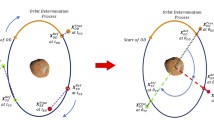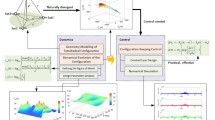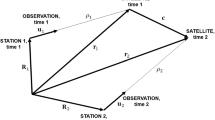Abstract
In this paper, we consider the design of minimum time maneuvers for multi-spacecraft interferometric imaging systems. We show that the process of image formation in a multi-spacecraft interferometric imaging system is analogous to painting a “large disk” with smaller “paintbrushes,” while satisfying a paint thickness constraint. We show that spiral maneuvers form the dominant set for the painting problem. Further, we frame the minimum time problem in the space of spiral maneuvers and obtain the Double Pantograph Problem. We show that the solution of a discretized version of the Double Pantograph Problem is given by the solution to two associated linear programming problems. We illustrate our results through an imaging example where the image of a fictitious exo-solar planet is formed using the maneuver prescribed by the Double Pantograph Problem.
Similar content being viewed by others
References
QUIRRENBACH, A. “Optical Inteferometry,” Annual Review in Astronomy and Astrophysics, 39, 2001, pp. 353–401.
BORUCKI, W. J., KOCH, D. G., DUNHAM, E. W., and JENKINS, J. M. “The Kepler Mission: A Mission to Determine the Frequency of Inner Planets Near the Habitable Zone of a Wide Range of Stars,” presented at Planets beyond our Solar System and Next Generation Space Missions, ASP Conference Series, 16–18 Oct. 1996.
CHAKRAVORTY, S., KABAMBA, P. T., and HYLAND, D. C. “Guaranteed Classification Performance of Multi-Spacecraft Interferometric Imaging Systems,” The Journal of the Astronautical Sciences, Vol. 51, No. 2, April–June 2003, pp. 205–226.
GOODMAN, J. W. Introduction to Fourier Optics, McGraw Hill, Boston, MA, 1996.
FITCH, J. P. Synthetic Aperture Radar, Springer-Verlag, Berlin, 1987.
CHAO, C. C., POLLARD, J. E., and JANSON, S. W. “Dynamics and Control of Cluster Orbits for Distributed Space Missions,” presented as paper AAS 99-126 at the AAS/AIAA Space Flight Mechanics Meeting, Breckenridge, CO, February 7–10, 1999.
WANG, P. K. C. and HADEAGH, F. Y. “Coordination and Control of Multiple Microspace-craft Moving in Formation,” The Journal of the Astronautical Sciences, Vol. 44, No. 3, 1996, pp. 315–355.
KONG, E.M.C., MILLER, D.W., and SEDWICK, R.J. “Exploiting Orbital Dynamics for Aperture Synthesis Using Distributed Satellite Systems: Applications to Visible Earth Imager System,” The Journal of the Astronautical Sciences, Vol. 47, Nos. 1–2, 1999, pp. 53–75.
CHOBOTOV, A. (ed.) Orbital Mechanics, AIAA, Reston, VA, 1996.
CLOHESSY, W.H. and WILTSHIRE, R.S. “Terminal Guidance System for Satellite Rendezvous,” Journal of Aerospace Sciences, 1960, 27 (9), pp. 653–658.
REDDING, D. C., ADAMS, N. J., and KUBIAK, E. T. “Linear-Quadratic Station-keeping for the STS Orbiter,” Journal of Guidance, Dynamics, and Control, 2000, 23, pp. 248–255.
SABOL, C., BURNS, R., and MCLAUGHLIN, C. “Formation Flying Design and Evolution,” Proceedings of the AAS/AIAA Space Flight Mechanics Meeting, presented as paper AAS 99-121, Breckenridge, CO, February 7–10, 1999, pp. 265–285.
SCHAUB, H., JUNKINS, J.L., and ALFRIEND, K.T. “Spacecraft Formation Flying Using Mean Orbit Elements,” Proceedings of the AAS Guidance and Control Conference, presented as paper AAS 99-310, Breckenridge, CO, February 3–7, 1999, pp. 69–87.
VASSAR, R. H. and SHERWOOD, R. B. “Formation-Keeping for a Pair of Satellites in Circular Orbit,” Journal of Guidance, Control, and Dynamics, 1985, 8 (2), pp. 235–242.
YAN, Q., KAPILA, V., and SPARKS, A.G. “Pulse-based Periodic Control for Spacecraft Formation Flying,” Proceedings of the American Control Conference, Chicago, IL, June 2000, pp. 374–378.
HADEAGH, F.Y., LU, W.M., and WANG, P.C. “Adaptive Control of Formation Flying Spacecraft for Interferometry,” Proceedings of the IFAC Conference on Large Scale Systems, Rio Patras, Greece, 1998, pp. 97–102.
YAN, Q., YANG, G., and KAPILA, V. “Nonlinear Dynamics, Trajectory Generation and Adaptive Control of Multiple Spacecraft in Periodic Relative orbits,” Proceedings of the AAS Guidance and Control Conference, presented as paper 00-013, Breckenridge, CO, 2000, pp. 159–175.
DEQUEIROZ, M. S., YAN, Q., YANG, G., and KAPILA, V. “Global Output Feedback Tracking Control of Spacecraft Formation Flying with Parametric Uncertainty,” Proceedings of the IEEE Conference on Decision and Control, Phoenix, AZ, Dec. 1999, pp. 584–589.
MORTON, B., WEININGER, N., and TIERNO, J.E. “Collective Management of Satellite Clusters,” Proceedings of the AIAA Guidance, Navigation, and Control Conference, Portland, OR, 1999, pp. 1576–1584.
YAN, Q., YAN, G., and KAPILA, V. “Nonlinear Dynamics and Output Feedback Control of Multiple Spacecraft in Elliptical Orbits,” Proceedings of the American Control Conference, Chicago, Il, 2000, pp. 839–843.
YANG, G., YANG, Q., KAPILA, V., PALMER, D., and VAIDYANATHAN, R. “Fuel Optimal Maneuvers for Multiple Spacecraft Formation Reconfiguration Using Multi-Agent Optimization,” Internationaljournal of Robust Nonlinear Control, 2002, 12, pp. 243–283.
MCINNES, C. R. “Autonomous Ring Formation for a Planar Constellation of Satellites,” Journal of Guidance, Control, and Dynamics, Vol. 18, No. 5, 1995, pp. 1215–1217.
ANDERSON, M. R. and ROBBINS, A. C “Formation Flight as a Co-Operative Game,” Proceedings of the AIAA conference on Guidance, Navigation, and Control, Boston, MA, 1998, pp. 244–251.
BEARD, R. W. and HADEAGH, F. W. “Constellation Templates : An Approach to Autonomous Formation Flying,” Proceedings of the World Automation Congress, Anchorage, AK, 1998, pp. 177.1–177.6.
BEARD, R. W. “Architecture and Algorithms for Constellation Control,” Technical Report, Jet Propulsion Laboratory, California Institute of Technology, Pasadena, CA, March 1998.
BEARD, R. W., LAWTON, J. W. and HADEAGH, F. W. “A Co-Ordination Architecture for Spacecraft Formation Control,” IEEE Transactions on Control Systems Technology, Vol. 9, No. 6, 2001, pp. 777–790.
DECUE, A.B. “Orbital Station-Keeping for Multiple Spacecraft Interferometry,” The Journal of the Astronautical Sciences, Vol. 39, No. 3, 1991, pp. 283–297.
LUENBERGER, D.G. Linear and Nonlinear Programming, Addison-Wesley, Reading, MA, 1984.
CHAKRAVORTY, S. Design and Optimal Control of Multi-Spacecraft Interferometric Imaging Systems, Ph.D thesis, University of Michigan, 2004.
Author information
Authors and Affiliations
Corresponding author
Rights and permissions
About this article
Cite this article
Chakravorty, S., Kabamba, P.T. & Hyland, D.C. Design of Minimum Time Maneuvers for Multi-Spacecraft Interferometric Imaging Systems. J of Astronaut Sci 52, 301–329 (2004). https://doi.org/10.1007/BF03546366
Published:
Issue Date:
DOI: https://doi.org/10.1007/BF03546366




